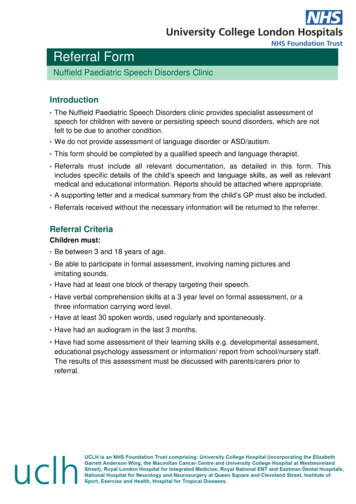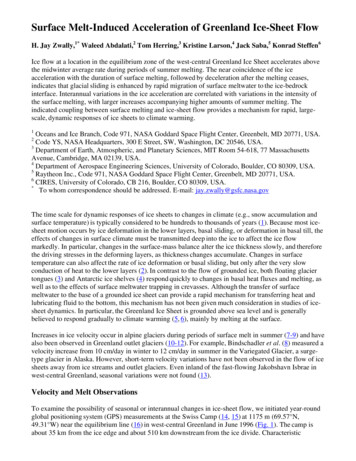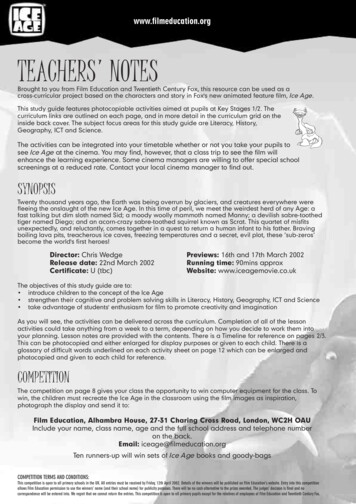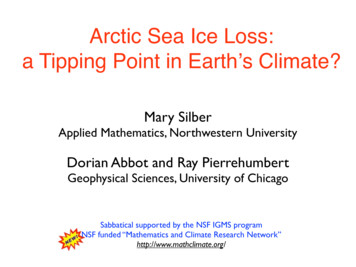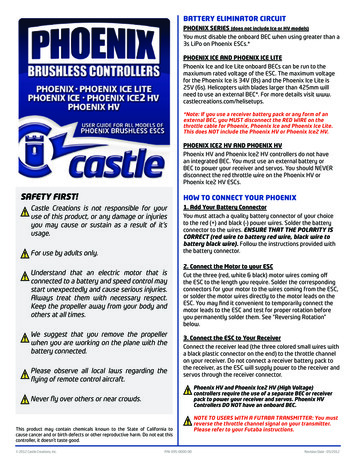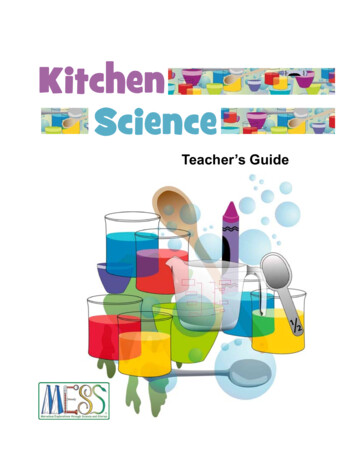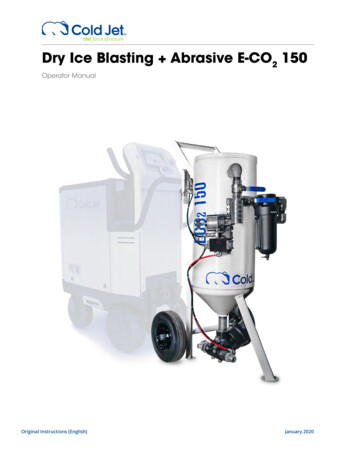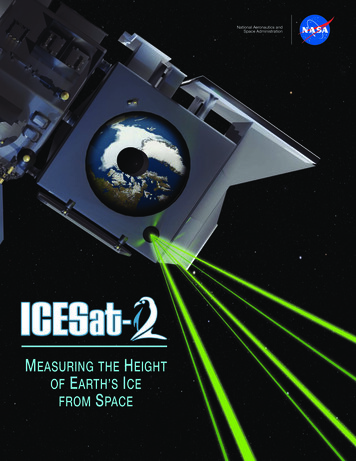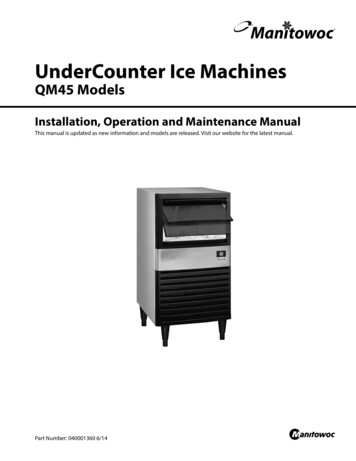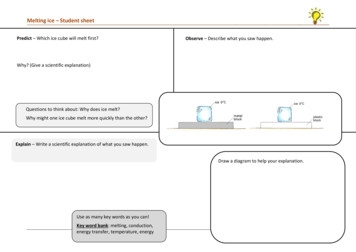
Transcription
Melting ice – Student sheetPredict – Which ice cube will melt first?Observe – Describe what you saw happen.Why? (Give a scientific explanation)Questions to think about: Why does ice melt?Why might one ice cube melt more quickly than the other?Explain – Write a scientific explanation of what you saw happen.Draw a diagram to help your explanation.Use as many key words as you can!Key word bank: melting, conduction,energy transfer, temperature, energy
Melting ice – Student sheetWhy does ice melt faster on metal than it does on plastic?Read this answer and compare it to your own.Ice is at a temperature of 0 C; the surroundings are at about 20 C.For ice to melt, it must gain energy from the surroundings.Energy can be transferred (move) from the surroundings to the ice byconduction through the metal or plastic. Metal is a better conductorthan plastic, so energy is transferred more quickly through the metal.This is why we saw the ice on the metal block melt more quickly.(Note that a small amount of energy may enter the ice from the air,but this is a small effect compared to conduction through themetal/plastic because air has very little mass.)1 What did you do well in your answer?.2 What could you improve?.Now go back and improve your answer.Nuffield Practical Work for Learning: Argumentation Melting ice Student sheets Nuffield Foundation 2013 downloaded from www.nuffieldfoundation.orgpage 2 of 2
Melting ice – Assessing learningTrue or false?Decide whether each of the following statements is true or false.For those which are false, cross out the incorrect words and write acorrection in the space underneath it.true / false1 A block of ice will melt when energy escapes from it.Correction:2 Plastics are good conductors of heat energy.Correction:3 Ice cream will melt more quickly if it falls on a metal benchthan on a wooden one.Correction:4 Frozen food will thaw quickly if placed on a ceramic (china)plate.Correction:5 Energy is conducted from a place where the temperature ishigher to a place where the temperature is lower.Correction:Nuffield Practical Work for Learning: Argumentation Melting ice Student sheets Nuffield Foundation 2013 downloaded from www.nuffieldfoundation.orgpage 1 of 2
Melting ice – Assessing learningPlastic vs glassTo studyJo has a flat piece of plastic and a similar piece of glass. She wants toknow which is a better thermal conductor (conductor of heat), theplastic or the glass.She places an ice cube on top of each of the two pieces.She sees that the ice on the glass melts more quickly than the ice onthe plastic.To answera Explain why the ice cubes melt.b Which is a better conductor, glass or plastic? Explain how you know.c Suggest two ways in which Jo could ensure that her experiment is afair test.d Jo challenges her friend Jay. She says, ‘The ice melted more quickly onthe glass than on the plastic. If you touch the two materials, which willfeel warmer?’Jay says that he thinks the glass will feel warmer and that is why the icemelted more quickly on the glass.Explain why he is wrong.Nuffield Practical Work for Learning: Argumentation Melting ice Student sheets Nuffield Foundation 2013 downloaded from www.nuffieldfoundation.orgpage 2 of 2
Melting ice – Teacher guidanceLearning structure of the lessonThe big pictureThis lesson is designed to exemplify an argumentation approach to practical work,using a ‘predict-observe-explain’ framework.Students often think that some materials are intrinsically warm (wood, plastic, wool)while others are intrinsically cold (metals, glass, water). This lesson challenges theseideas by presenting observations which many will find counter-intuitive. Throughargumentation, students predict the outcome of an experiment, observe the result,and discuss how scientific ideas about energy transfer can explain what they see.Age range: 12–14(Could be adapted for 14–16)Timing: 50 minutesLearning episode 1 (teacher-led) 5 minsLearning outcomesEquipment and materialsIntroduce lesson objectives. Explain what makes agood argument. Pass the metal and plastic blocksaround. In small groups students discuss how theblocks feel to touch.Students will be able to:Teacher guidancePractical guidanceSlide presentationLearning episode 2 (student-led) 15 mins generate and evaluatescientific argumentsIntroduce the practical. Students discuss and writedown their prediction. Groups must justify theirprediction with an explanation using scientific ideas. present a scientificargument using wordsand diagramsA few groups report back to the class. The rest of theclass say whether they agree or disagree and whetherthey can improve the predictions and justifications.Student sheetPer groupMetal and plastic blocks (oneof each)Supply of ice cubesOptionalCamera linked to dataprojectorLearning episode 3 (teacher-led) 5 minsStudents carry out the practical activity and makeobservations. Alternatively the practical can be carriedout as a teacher demonstration.Learning episode 4 (student-led) 30 minsGroups discuss their observations and decide whethertheir prediction was correct. They agree an explanationfor what they have seen, and develop an argument forwhy they think their explanation is correct.A few groups report back to the class. The rest of theclass say whether they agree or disagree, and whetherthey have something to add. describe how energy istransferred through asolid conductor fromhigher to lowertemperatureRefer to the health and safetyadvice and practical guidance apply ideas about energytransfer by thermalconduction in unfamiliarsituations.Groups self assess their explanation against the modelanswer. Allow groups to improve their explanations.Ask students what makes a good argument and howthey went about developing their own arguments.Key wordsMelting, conduction, energy transfer, temperature, argument, claim, evidence / data(For a discussion of the terms heat and temperature at-and-temperature).Nuffield Practical Work for Learning: Argumentation Melting ice Teacher guidance Nuffield Foundation 2013 downloaded from www.nuffieldfoundation.orgpage 1 of 8
Melting ice – Teacher guidancePrior knowledgeThis lesson makes use of ideas about energy transfer, in particular, conductionof heat. It could be used to consolidate these ideas, or (with some adaptation) asan introduction to conduction.It is assumed that students know the following. Ice melts at 0 C.Other relevant background knowledge that supports this lesson includes: Energy must be supplied to make ice melt.Energy is transferred from higher to lower temperature.Energy is transferred through solids by conduction.Some materials are better conductors than others.Students may also be familiar with the mechanisms of conduction.Background informationTo melt ice, energy must be supplied. Energy is transferred from hotter to colderplaces by conduction, convection and radiation, i.e. temperature differenceresults in energy transfer. Metals are better conductors than plastics.TerminologyThe terms which students need to understand and use in this lesson are:melting – the change from solid to liquid; energy must be supplied to cause asolid to meltconduction – the transfer of energy through a solid or liquid without thematerial itself movingenergy transfer – the movement of energy from one place to anothertemperature – a measure of the hotness or coldness of an objectargument – the process that students use to articulate, support and justifyclaims or conclusionsclaim – a conclusion, idea, proposition or assertionevidence / data – the observations and accepted scientific theories used tosupport the claimNote that in this resource we have used the term energy throughout. Energywhich is transferred due to a temperature difference is sometimes known asheat or heat energy (or even thermal energy, although this is not a standardterm). Conduction is sometimes described as a thermal energy transfer. You willhave to decide if any of these terms are appropriate to your own scheme ofwork.Nuffield Practical Work for Learning: Argumentation Melting ice Teacher guidance Nuffield Foundation 2013 downloaded from www.nuffieldfoundation.orgpage 2 of 8
Melting ice – Teacher guidanceDifferentiation For less confident students, the lesson can be used after they have learnedabout thermal conduction. They can then be challenged to use what theyhave learned – that metals are better conductors than plastics, and so on. Additional scaffolding could be provided as a description and explanation ofthe experiment as a series of statements on separate cards for students tosequence. Add greater challenge to the lesson by using it to introduce ideas aboutthermal conduction. The lesson can challenge students to address theconflict between their everyday ideas (plastic is warm, etc.) and theobservation that ice melts more quickly on metal.Optional extension activities Pass round samples of other materials (e.g. wood, glass, acrylic, expandedpolystyrene, copper) similar to the plastic and metal blocks and ask ‘On whichof these would ice melt quickly; on which would ice melt more slowly?’ Iftime allows, try it out. Use the ‘further questions’ on slide 10.Answers to further questions1 The results would be the same, because the metal box would conductenergy from the surroundings to the inside of the box more quickly thanthe plastic box.2 Place an ice cube on a sample of each material, making sure that thesamples are all in the same environment. Time the ice cubes melting. Thebest conductor will result in the fastest melting ice cube.3 When you touch a material that is a good conductor, energy escapes fromyour finger. This cools the skin and receptors in the skin detect a decreasein temperature. Diamond shows this effect and so must be a goodconductor – its thermal conductivity is higher than any metal. You could repeat the practical as a demonstration with temperature probesattached to the blocks. Can students predict how the readings will change?There is a video of this ce/2087/thermalconductivityNuffield Practical Work for Learning: Argumentation Melting ice Teacher guidance Nuffield Foundation 2013 downloaded from www.nuffieldfoundation.orgpage 3 of 8
Melting ice – Teacher guidanceLesson detailsSlide 2Task: Pass the metal and plastic blocks around sothat students can feel them.Explain: Introduce objectives for lesson, andexplain what makes a good scientific argument.The lesson is about energy transfers andworking together to develop scientificarguments. A good scientific argument usesevidence and scientific ideas to justify a claim.At the end, students will be able to give betterexplanations of phenomena that involveconduction.Task: Check students understand key terminology– heat, temperature, energy, energy transfer etc.Slide 3Task: In groups of three, students discuss (andcould also write down) words to describe how thetwo blocks felt to the touch.Discussion should concentrate on ‘similarities’and ‘differences’. Encourage students to thinkabout the materials the blocks are made ofrather than the shape of the blocks.Putting students in groups of three rather thanpairs is more likely to result in debate in thenext part of the lesson.Slide 4Explain: Explain that you are going to place an icecube on each block. Ask the first two questions onslide 4. Give students 1 minute to discuss in theirgroups.Where one person in a group disagrees withthe other two, they should be given priority toexplain their ideas.Task: While students are discussing, give out the‘Predict, Observe, Explain’ A3 placemats.Nuffield Practical Work for Learning: Argumentation Melting ice Teacher guidance Nuffield Foundation 2013 downloaded from www.nuffieldfoundation.orgpage 4 of 8
Melting ice – Teacher guidanceA3 placematTask: Direct students towards the ‘Predict’ sectionof the A3 placemats.Use the prompt questions (also on slide 4) toensure groups justify their prediction with anexplanation using scientific ideas. Initialexplanations may include the idea that ‘metalsare cold’. Asking why ice melts should promptthoughts about energy transfer.Task: Give groups a further 2–3 minutes to finishtheir discussion and complete the ‘Predict’ section.Task: Two groups give a 30–60 second report tothe class explaining their thinking. If possible,choose one proposing plastic, the other metal.After this allow each group to say why theyconsider the other argument to be incorrect.Ask the rest of the class to suggest whether theyagree or disagree with the presented argumentsand whether they can improve them.A3 placematPracticalTask: Students carry out the practical activity (seePractical guidance). Alternatively demonstrate thephenomenon.Each group will need a pair of blocks and twoice cubes. They place the ice cubessimultaneously on the blocks, then leave themto observe what happens.The ice on metal melts first. Ask, ‘Who issurprised?’Task: Students write their observations on the A3placemat.Slide 5Task: Give groups 2 minutes to discuss in theirgroups what they have seen and to decidewhether their prediction was correct.If their prediction was incorrect, ask them to tryand explain what they saw.Differentiation: Students may already bethinking in terms of energy. You may need toremind some students that metals areconductors and plastics are insulators, andhow energy is transferred through solids.Nuffield Practical Work for Learning: Argumentation Melting ice Teacher guidance Nuffield Foundation 2013 downloaded from www.nuffieldfoundation.orgpage 5 of 8
Melting ice – Teacher guidanceSlide 6Task: After 2 minutes, each group should agree anexplanation for what they have seen, and developan argument for why they think their explanationis correct.To develop an argument, students will need tosupport their explanation with evidence (i.e.what they saw happening and their existingknowledge of melting ice). Use the promptquestions (on slide 6) to direct their thinking.Option: Slide 7Challenge students to justify their explanationsby offering up counter-claims for them toaddress, e.g. Ask questions such as, ‘Why don’tyou think it was the temperature of the metalwhich made the ice melt faster?’Optional: A video of the practical activity may beused to remind students of what they have seen(slide 7).A3 placematTask: Students write their explanations, using keywords, and draw a diagram, on the placemat. Anexample of the type of diagram that could be usedis on slide 8.Differentiation: You could provide adescription and explanation of the experimentas a series of statements on separate cards forstudents to sequence.Option: Slide 8Task: Get one or two groups to share theirexplanations with the class. Ask others where theydisagree, or where they have something to add.You could give students coloured cards to holdup to indicate if they disagree (red card) or ifthey have something to add (orange card).Nuffield Practical Work for Learning: Argumentation Melting ice Teacher guidance Nuffield Foundation 2013 downloaded from www.nuffieldfoundation.orgpage 6 of 8
Melting ice – Teacher guidanceOption: Slide 9Differentiation: Add greater challenge by askingstudents to explain why the ‘plastic is warmer’idea is not supported by their observations, andwhy metal feels colder to touch than plastic(see slide 9).Task: Give groups the model answer and ask themto compare it with their own. Each group identifieswhat they have done well and how they couldimprove. Allow groups to improve their answers.Worksheet 1Differentiation: More scaffolding could involvereading through the model answer anddiscussing how students’ explanations comparewith it.Task: Ask students what makes a good argumentand how they went about developing their ownarguments. They should explain the importance ofusing evidence to support a claim.Worksheet 2ORTask: Students complete either the true/falsequestions (less challenge) or the plastic vs. glassquestions (greater challenge). These provide anopportunity to apply what they have learnt aboutconduction.Option: Slide 10Optional: The ‘further questions’ on slide 10 canbe used as an extension exercise or for homework.Nuffield Practical Work for Learning: Argumentation Melting ice Teacher guidance Nuffield Foundation 2013 downloaded from www.nuffieldfoundation.orgpage 7 of 8
Melting ice – Teacher guidanceAssessing learning: Answers to questions on the student sheetsTrue or falsetrue / false1 A block of ice will melt when energy escapes from it.falseCorrection: is transferred into2 Plastics are good conductors of heat energy.falseCorrection: poor/bad (or change conductors to insulators)3 Ice cream will melt more quickly if it falls on a metal bench than on awooden one.trueCorrection:4 Frozen food will thaw quickly if placed on a ceramic (china) plate.falseCorrection: metal (or change ‘quickly’ to ‘slowly’)5 Energy is conducted from a place where the temperature is higher toa place where the temperature is lower.trueCorrection:Plastic vs. glassa The ice is colder than its surroundings. Energy from the warmer surroundingsis conducted through the glass or plastic to the colder ice, melting it.b Glass is a better conductor. Energy moves more quickly through the glass thanthe plastic, causing the ice to melt more quickly.c The pieces of plastic and glass should be the same thickness (and area); the icecubes should be the same mass (and at the same temperature).Note: This experiment would only be a fair test if the two materials also hadsimilar values of specific heat capacity, but we can ignore this.d The plastic will feel warmer. This is because, when you touch the glass, energyfrom your finger is conducted into the glass, lowering the temperature of yourfinger. The glass feels cold. Energy is conducted only very slowly into the plasticbecause it is a better thermal insulator, so your finger does not cool, and it doesnot detect a lower temperature.Nuffield Practical Work for Learning: Argumentation Melting ice Teacher guidance Nuffield Foundation 2013 downloaded from www.nuffieldfoundation.orgpage 8 of 8
Melting ice – Practical guidanceA video of the practical, without a commentary, can be found ce/2087/thermal-conductivityClick on the link to the video: ‘Thermal conductivity demonstration only’. Thereis also a link to this in the slide presentation.Equipment and materialsPer groupMetal and plastic blocks (one of each) – see notesSupply of ice cubesPer classOptional: Flexicam linked to data projectorHealth and safety and technical notesBefore carrying out this practical, users are reminded that it is theirresponsibility to carry out a risk assessment in accordance with their employer’srequirements, making use of up-to-date information.Read our standard health & safety guidance.1 The blocks should be about the same size and shape (perhaps 5 cm square and1 cm thick) and preferably have the same colour. Caution: metal blocks could beheavy. Suitable blocks are commercially available; these have a rim to preventthe melting ice from slipping off. For example,www.timstar.co.uk/Item/NA/HE92305/ice melting kit.html2 To prevent the ice sliding off blocks without a rim, a thin roll of Blu-tack couldbe used around the edge.3 If a plastic block is not available, a wooden block could be used.4 The blocks should be at the same temperature (room temperature) before thedemonstration.5 If there are not enough blocks available for this to be carried out as a studentpractical, it could be run as a demonstration. A camera linked to a projectorwould help to make the demonstration more visible.Procedurea Simultaneously place one ice cube on the metal block and one ice cube onthe plastic block.b Observe the rate at which the two ice cubes melt.Nuffield Practical Work for Learning: Argumentation Melting ice Practical guidance Nuffield Foundation 2013 downloaded from www.nuffieldfoundation.orgpage 1 of 1
Why does ice melt faster on metal than it does on plastic? Read this answer and compare it to your own. Ice is at a temperature of 0 C; the surroundings are at about 20 C. For ice to melt, it must gain energy from the surroundings. Energy can be transferred (move) from the surroundings to the ice by conduction through the metal or plastic.
